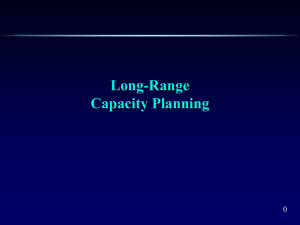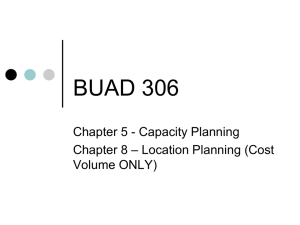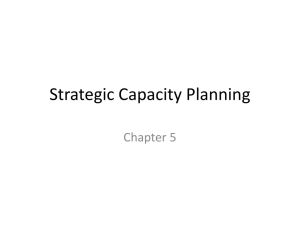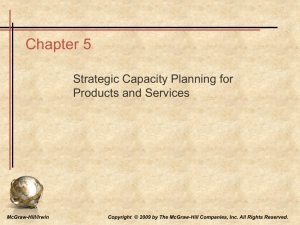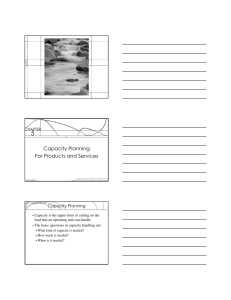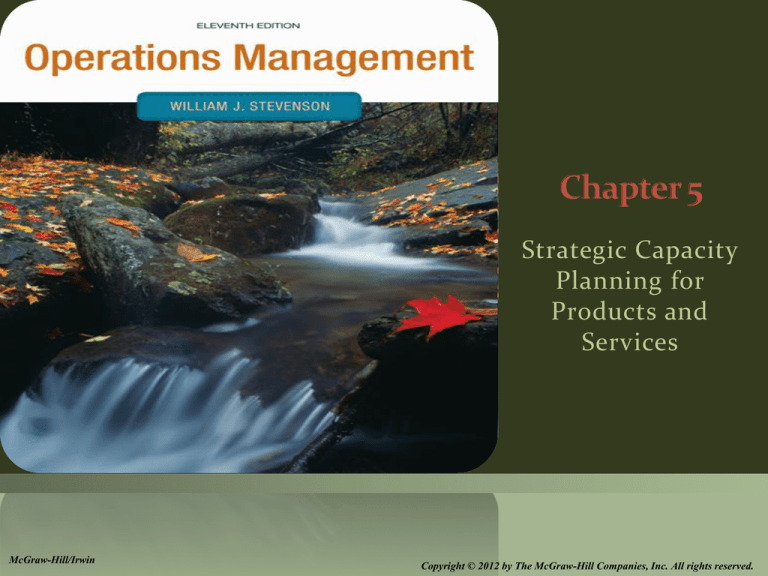
Strategic Capacity
Planning for
Products and
Services
McGraw-Hill/Irwin
Copyright © 2012 by The McGraw-Hill Companies, Inc. All rights reserved.
Capacity
The upper limit or ceiling on the load that an operating
unit can handle
Capacity needs include
Equipment
Space
Employee skills
Instructor Slides
5-2
Strategic Capacity Planning
Goal
To achieve a match between the long-term supply
capabilities of an organization and the predicted level
of long-run demand
Over-capacity operating costs that are too high
Under-capacity strained resources and possible loss of
customers
Capacity
Design capacity
maximum output rate or service capacity an operation, process, or
facility is designed for
Effective capacity
Design capacity minus allowances such as personal time,
maintenance, and scrap
Actual output
rate of output actually achieved
Cannot exceed effective capacity.
Measuring System Effectiveness
Efficiency
Utilization
actual output
Efficiency
effective capacity
actual output
Utilization
design capacity
Measured as percentages
Example– Efficiency and Utilization P. 197
Design Capacity = 50 trucks per day
Effective Capacity = 40 trucks per day
Actual Output = 36 trucks per day
actual output
36
Efficiency
90%
effective capacity 40
actual output
36
Utilizatio n
72%
design capacity 50
Capacity Cushion
Capacity Cushion
Extra capacity used to offset demand uncertainty
Capacity cushion = 100% - Utilization
Capacity cushion strategy
Organizations that have greater demand uncertainty
typically have greater capacity cushion
Organizations that have standard products and services
generally have smaller capacity cushion
Example 2, P 202
A center works one shift (8-hr shift), 250 days a
year, and these figures for a machine that is
current being considered:
Annual
Stand Processing
Processing
Product
Demand Time per Unit (hr) Time Needed
#1
400
5
5 x 400=2000
#2
300
8
8 x 300=2400
#3
700
2
2 x 700=1400
Total: 5800
Example 2, P. 202 (Cont’d)
How many machines do we need to
handle the required volume?
Total Requires 5800 Hrs
8 Hrs/day x 250 days/Yr
5800Hrs
2.9 machines
2000Hrs
In-House or Outsource?
Once capacity requirements are determined, the
organization must decide whether to produce a good or
service itself or outsource
Factors to consider:
Available capacity
Expertise
Quality considerations
The nature of demand
Cost
Risks
Bottle Neck Operation
Complementary Demand Patterns
Average cost per unit
Optimal Operating Level
Minimum
cost
Optimal
Output
Rate
Rate of output
Average cost per unit
Minimum cost & optimal operating rate are
functions of size of production unit.
Small
plant
Medium
plant
Large
plant
Output rate
Instructor Slides
5-14
Cost-Volume Analysis
Cost-volume analysis
Focuses on the relationship between cost, revenue, and
volume of output
Fixed Costs (FC)
tend to remain constant regardless of output volume
Variable Costs (VC)
vary directly with volume of output
VC = Quantity(Q) x variable cost per unit (v)
Total Cost (TC)
TC = FC+VC=FC+Q x v
Total Revenue (TR)
TR = revenue per unit (R) x Q
Cost-Volume Relationships
Break-Even Point (BEP)
BEP
The volume of output at which total cost and total
revenue are equal
Profit (P) = TR – TC = R x Q – (FC +v x Q)
Profit (P) = Q(R – v) – FC
Q profit
P FC
Rv
QBEP
FC
Rv
Example 3: P. 211
If FC=$6000/Month, VC=$2/pie, Price=$7/pie
How many pies must be sold to Break Even?
QBEP
FC
6000
1200 Pies / Month
Re venue VC 7 2
If 1000 pies sold in a month, What would be the
profit or loss?
Profit=TR-TC=$7(1000)-($6000+$2x1000)= -$1000
Loss $1000
Example 3: P. 211 (Cont’d)
How many pies must be sold for a profit of $4000?
QPr ofit
Pofit FC 4000 6000
2000 Pies
R V
72
If 2000 pies can be sold, a profit goal is $5000, what price
should be charged per pie?
Profit = Q(R-v) – FC
5000 = 2000(R – 2) – 6000
5000 = 2000R – 4000 – 6000
2000R= 15000
R = $7.50, Price = $7.50
Example 4: P. 212
A manager has the option of purchasing 1,2, or 3
machines. Fixed costs & potential volumes are as
follows:
# Machines Annual FC
Range of Output
1
$ 9,600
0 to 300
2
15,000
301 to 600
3
20,000
601 to 900
VC=$10/unit Revenue=$40/unit
Example 4: P. 212 (Cont’d)
Determine the break-even point for each range.
1 Machine Q(Bep)= 9600/(40-10)=320units (not in range)
2 Machine Q(Bep)=15000/(40-10) =500units
3 Machine Q(Bep)=20000/(40-10)=666.7units
If projected annual demand is between 580 and
660 units, how machines should the manager
purchase?
Manager should choose 2 machines
Make or Buy
Available Capacity
Quality Consideration
Nature of Demand
Cost
Example 5: Make or Buy
Annual FC
VC/Unit
Annual Volume
MAKE
$150000
$60
12000 units
P. 216
BUY
0
$80
12000 units
Annual Cost of each alternative:
TC = FC + VC x Q
TCMake=$150000 +$60x12000=$870,000
TCBuy = 0
+$80x12000=$960,000
Alternative Make is better
Example 5: Make or Buy P. 216 (Cont’d)
There is a possibility that volume could change in the future.
What would be Indifferent Volume between Making & Buying?
TCMake = TCBuy
FC +V*Q = FC+V*Q
150000+60Q = 0 +80Q
150000=80Q - 60Q = 20Q
Q = 7500 units
If Volume >= 7500 units, Choose MAKE
If Volume <= 7500 units, Choose BUY


